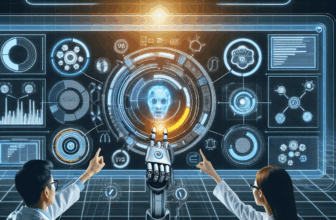Navigating the Future: How AI-Powered Real-Time Traffic Analysis Enhances Urban Mobility and Safety
Table of Contents
- 1. Introduction
- 2. Understanding AI and Traffic Analysis
- 3. Real-Time Traffic Data Collection
- 4. AI Algorithms for Traffic Management
- 5. Enhancing Urban Mobility
- 6. Improving Safety
- 7. Case Studies and Real-World Applications
- 8. Future Trends and Challenges
1. Introduction
The global urban landscape is evolving rapidly, driven by an ever-increasing population and the rising demand for sustainable transportation solutions. Urban areas, often characterized by dense populations, have become hotbeds of traffic congestion, pollution, and accidents. As cities strive to remain functional and efficient, they increasingly look towards innovative technologies to enhance the safety and mobility of their inhabitants. One such technology is Artificial Intelligence (AI), which has transformed various industries, including traffic management and urban planning.
This article delves into the role of AI-powered real-time traffic analysis in enhancing urban mobility and safety. By exploring the fundamental concepts of AI and traffic analysis, data collection methodologies, the implementation of AI algorithms, and the resultant benefits for urban environments, we aim to provide a comprehensive overview of how AI is reshaping our urban infrastructures.
2. Understanding AI and Traffic Analysis
2.1 The Basics of AI
Artificial Intelligence refers to the simulation of human intelligence processes by machines, especially computer systems. These processes include learning, reasoning, and self-correction. In the context of traffic analysis, AI utilizes vast amounts of data to make informed predictions and decisions. Techniques that fall under the umbrella of AI include machine learning (where algorithms learn from data), natural language processing, and computer vision.
Machine learning, in particular, has gained significant traction in analyzing traffic patterns. Algorithms are trained on historical data sets, enabling them to recognize trends, forecast traffic jams, and even detect anomalies. This capacity for pattern recognition empowers traffic management systems to make real-time adjustments based on predictive analytics.
2.2 Traffic Analysis Techniques
Traffic analysis consists of various methodologies aimed at understanding vehicular movement and optimizing road usage. Traditional techniques include manual counts, sensor data, and traffic cameras. However, AI introduces more sophisticated approaches, such as predictive analytics and deep learning algorithms. By integrating real-time data with historical traffic patterns, urban planners can enhance traffic flow, minimize congestion, and address safety concerns.
Traffic signal optimization is another crucial aspect where AI contributes significantly. Adaptive traffic signals, powered by AI, can adjust their timings based on real-time traffic conditions rather than relying solely on preset schedules. This leads to smoother traffic flow, reduced delays, and lower emissions in urban areas.
3. Real-Time Traffic Data Collection
3.1 Sensors and Cameras
The backbone of any AI-powered traffic system lies in its data collection capabilities. Advanced sensors and surveillance cameras installed throughout urban environments capture critical data related to vehicle counts, speeds, and traffic density. This data is crucial for understanding current traffic conditions and identifying patterns over time. Technologies such as LIDAR, RADAR, and advanced image processing techniques help in obtaining precise information regarding vehicular movement.
Moreover, the data collected from these sensors is often analyzed using cloud computing, allowing for the real-time processing of information. This abundance of data facilitates more accurate predictions and timely responses to emerging traffic situations.
3.2 Crowd-Sourced Data
In addition to sensors and cameras, crowd-sourced data from applications like Google Maps and Waze has revolutionized traffic analysis. Such platforms allow users to share real-time information about road conditions, accidents, and even speed traps. This information not only helps in navigating users efficiently but also enhances the overall traffic data pool available for analysis. The integration of crowd-sourced data with traditional data sources presents a comprehensive view of urban traffic dynamics, enriching predictive models and fostering better decision-making.
4. AI Algorithms for Traffic Management
4.1 Machine Learning Methods
Machine learning techniques, including supervised, unsupervised, and reinforcement learning, play a pivotal role in processing traffic data. Supervised learning, for instance, allows AI systems to learn from labeled datasets, leading to improved accuracy in predictions regarding traffic congestion and incidents. Unsupervised learning can reveal hidden patterns within the data, offering new insights into traffic flow that may not have been previously considered.
Reinforcement learning, on the other hand, empowers AI systems to learn from their actions by receiving feedback. This concept can be applied in real-time traffic signal control, where AI systems gradually improve their responses based on user interactions and traffic conditions.
4.2 Neural Networks
Neural networks, inspired by the human brain, are a cornerstone of modern AI. These networks consist of nodes (neurons) that process inputs and produce outputs through interconnected pathways. In traffic analysis, deep learning neural networks can analyze vast datasets, enabling the detection of complex patterns and correlations that may be too intricate for traditional processing methods. This capability is particularly valuable in forecasting traffic congestion and making proactive adjustments to traffic management systems.
5. Enhancing Urban Mobility
5.1 Traffic Flow Optimization
AI technologies significantly enhance traffic flow optimization efforts by continually analyzing data and adjusting traffic signals in real time. Through these measures, cities can reduce congestion during peak hours, minimize travel time for commuters, and improve the overall driving experience. AI systems can predict high-traffic scenarios and reroute vehicles accordingly, utilizing alternative paths to alleviate bottlenecks.
This proactive approach not only mitigates delays but also minimizes fuel consumption and corresponding emissions, contributing to healthier urban settings. Furthermore, as cities grow, a scalable AI-powered traffic management system can adjust and incorporate new data sources, ensuring sustainable mobility solutions in the long term.
5.2 Public Transport Efficiency
Efficient public transportation is vital for urban mobility, and AI can significantly enhance this sector. By analyzing traffic patterns and rider data, AI systems can optimize bus routes, reducing wait times and improving frequency during peak hours. Additionally, AI-driven predictive analytics can provide real-time updates to passengers, allowing them to plan their journeys effectively.
Moreover, integrating public transport systems with private vehicle traffic using AI can result in a cohesive urban mobility strategy. As more commuters opt for public transport, cities can reduce congestion and enhance their overall functionality.
6. Improving Safety
6.1 Accident Prevention
AI's application extends beyond improved traffic flow; it plays a crucial role in enhancing safety on the roads. AI systems analyze historical data to identify accident-prone areas and times, allowing urban planners to implement necessary changes, such as improved signage or adjusted traffic signals. Moreover, AI can assist in the design of smarter road systems, with features tailored to mitigate risks based on predictive models of crash occurrences.
Real-time monitoring solutions also enable immediate alerts to authorities in the event of accidents, allowing for faster emergency responses and potentially saving lives.
6.2 Emergency Response Enhancements
In emergencies, every second counts. AI-enhanced traffic systems can expedite emergency vehicles' routes by adjusting signal timings, clearing congested areas, and providing optimal paths based on real-time data. This streamlined approach boosts the effectiveness of emergency response teams, ensuring that they can reach their destinations swiftly and safely, thus improving overall public safety.
7. Case Studies and Real-World Applications
7.1 Cities Successfully Implementing AI Traffic Solutions
Several cities worldwide are at the forefront of integrating AI into their traffic management systems. For instance, Los Angeles has employed AI algorithms to optimize traffic signal timing, resulting in smoother traffic flow and reduced congestion. The city has also integrated crowd-sourced data from mobile applications such as Waze to enhance situational awareness.
Similarly, Barcelona enacted an AI-driven intelligent traffic management system that detects congestion levels across its busiest routes and adjusts traffic signals accordingly. This adaptive signal control technology has significantly improved the efficiency of the city’s transportation network.
7.2 Lessons Learned from Failures
Despite its potential, the implementation of AI in traffic management is not without its challenges. Some municipalities have struggled with the integration of legacy systems and faced difficulties in achieving public acceptance of new technologies. A notable example is the stalled rollout of smart traffic lights in certain U.S. cities due to public pushback against surveillance concerns.
These lessons underline the importance of community engagement, transparency, and sensitivity to public concerns when implementing AI technologies in urban settings.
8. Future Trends and Challenges
8.1 The Role of Autonomous Vehicles
The advent of autonomous vehicles presents new opportunities and challenges for urban traffic management. As these vehicles gradually integrate into the existing infrastructure, AI systems may need to evolve to accommodate their unique traffic patterns. AI will play a crucial role in facilitating communication between autonomous vehicles and traffic management systems, enabling better coordination and traffic optimization.
Moreover, the introduction of shared autonomous vehicles may lead to a reduction in the number of vehicles on the road, significantly altering urban mobility dynamics. As this trend progresses, cities must be prepared to adapt their traffic management systems accordingly.
8.2 Challenges to Implementation
While the benefits of AI-powered traffic analysis are substantial, challenges remain. Issues such as data privacy, algorithm bias, and the need for substantial investment in infrastructure can hinder progress. Additionally, collaboration between various stakeholders, including city planners, technology providers, and the public, is essential for achieving successful implementation. Addressing these challenges will require a concerted effort and commitment to fostering an open dialogue between all parties involved.
Frequently Asked Questions (FAQ)
Q: How does AI improve traffic management?
A: AI improves traffic management by analyzing large datasets in real-time to optimize traffic signals, predict congestion, and enhance public transport efficiency. It utilizes advanced algorithms to make immediate adjustments, increasing overall urban mobility and safety.
Q: What technologies are used in AI-powered traffic systems?
A: Technologies include machine learning algorithms, neural networks, vision recognition systems, advanced sensors, and crowd-sourced data platforms. These components work together to analyze traffic patterns and optimize management strategies.
Q: Are there privacy concerns with AI traffic monitoring?
A: Yes, privacy concerns exist, particularly regarding data collection and surveillance. It's crucial for cities using AI traffic systems to implement transparent policies regarding data use and ensure the protection of individuals' privacy.
Q: Can AI traffic analysis reduce vehicle emissions?
A: Absolutely. By optimizing traffic flow and reducing congestion, AI traffic analysis can lead to lower fuel consumption and, consequently, reduced vehicle emissions. Improved public transport also contributes to decreased environmental impact.
Resources
| Source | Description | Link |
|---|---|---|
| MIT Technology Review | Insights into AI developments in transportation. | Visit Site |
| Statista | Statistical data on urban traffic trends. | Visit Site |
| Waze | Crowd-sourced traffic and navigation application. | Visit Site |
| U.S. Department of Transportation | Information on smart transportation initiatives. | Visit Site |
| Scientific American | Articles on AI and its applications in transportation. | Visit Site |
Conclusion
The integration of AI-powered real-time traffic analysis is undeniably influential in shaping the future of urban mobility and safety. Through advanced data collection methods, AI algorithms, and adaptive management solutions, cities can address the escalating challenges posed by traffic congestion and safety concerns. Successful implementations in various urban centers worldwide stand as testimony to the immense potential of these technologies.
As we look ahead, the synergy between AI and autonomous vehicles, coupled with ongoing advancements in sensor technologies, promises to further enhance urban mobility solutions. A careful approach towards addressing challenges such as data privacy and public acceptance will be crucial for the successful adoption of AI in traffic management. Continued research and development in this area could lead to even more innovative solutions for future urban planning.
Disclaimer: This article is produced by A.I. and is in Beta Testing. While the information provided is designed to be informative and useful, readers should seek additional resources and conduct their own research to verify the validity of the information provided.










